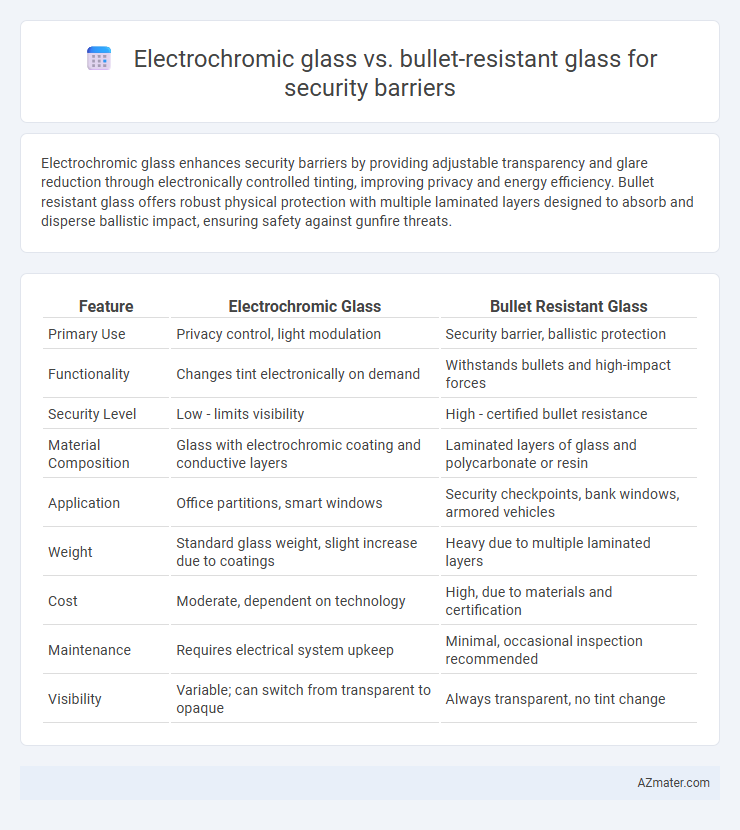Electrochromic glass enhances security barriers by providing adjustable transparency and glare reduction through electronically controlled tinting, improving privacy and energy efficiency. Bullet resistant glass offers robust physical protection with multiple laminated layers designed to absorb and disperse ballistic impact, ensuring safety against gunfire threats.
Table of Comparison
| Feature | Electrochromic Glass | Bullet Resistant Glass |
|---|---|---|
| Primary Use | Privacy control, light modulation | Security barrier, ballistic protection |
| Functionality | Changes tint electronically on demand | Withstands bullets and high-impact forces |
| Security Level | Low - limits visibility | High - certified bullet resistance |
| Material Composition | Glass with electrochromic coating and conductive layers | Laminated layers of glass and polycarbonate or resin |
| Application | Office partitions, smart windows | Security checkpoints, bank windows, armored vehicles |
| Weight | Standard glass weight, slight increase due to coatings | Heavy due to multiple laminated layers |
| Cost | Moderate, dependent on technology | High, due to materials and certification |
| Maintenance | Requires electrical system upkeep | Minimal, occasional inspection recommended |
| Visibility | Variable; can switch from transparent to opaque | Always transparent, no tint change |
Understanding Electrochromic Glass: Features and Functions
Electrochromic glass offers dynamic privacy and glare control by changing opacity with an electric charge, providing energy efficiency and enhanced user control in security barriers. This smart glass features low power consumption, rapid switching times, and durability against environmental factors, making it ideal for adaptive security environments. Unlike bullet-resistant glass, which prioritizes physical protection through multi-layer laminated construction, electrochromic glass emphasizes visual management without compromising structural integrity.
What is Bullet Resistant Glass? Key Characteristics
Bullet resistant glass is a laminated composite material designed to withstand high-velocity impacts from firearms, providing enhanced security for barriers and windows. Key characteristics include multiple layers of glass and polycarbonate, high bullet penetration resistance, durability, and transparency that does not compromise visibility. This specialized glass is rated according to standards such as UL 752, ensuring reliable protection against various calibers and ballistic threats in security applications.
Security Applications: Where Each Glass Excels
Electrochromic glass enhances security applications by providing dynamic visibility control, allowing for instant privacy and glare reduction in sensitive areas such as conference rooms or secure facilities. Bullet resistant glass excels in physical security by offering robust protection against ballistic threats, making it ideal for protecting entrances, checkpoints, and critical infrastructure from armed attacks. Combining these technologies can create security barriers that address both visibility management and impact resistance needs efficiently.
Performance Comparison: Strength and Durability
Electrochromic glass offers advanced light control and energy efficiency but generally lacks the high impact resistance required for robust security barriers. Bullet resistant glass provides exceptional strength and durability, engineered with multiple laminated layers to absorb and dissipate ballistic impacts effectively. For security barriers demanding maximum protection against forced entry or ballistic threats, bullet resistant glass significantly outperforms electrochromic glass in terms of strength and long-term durability.
Visual Control: Transparency and Privacy Differences
Electrochromic glass offers dynamic visual control by allowing users to switch between transparent and opaque states, providing adjustable privacy on demand. Bullet resistant glass, designed primarily for physical protection, remains consistently transparent but lacks the ability to modulate privacy levels. The key difference lies in electrochromic glass's adaptive transparency, enhancing privacy without compromising visibility, whereas bullet resistant glass ensures security through strength but with fixed visual properties.
Threat Protection: Effectiveness Against Forced Entry and Ballistics
Electrochromic glass provides dynamic opacity control for privacy and glare reduction but offers limited resistance to forced entry and ballistic threats due to its thin, layered structure. Bullet resistant glass, engineered with multiple layers of laminated polycarbonate and glass, delivers high-impact resistance capable of withstanding various ballistic calibers and preventing penetration during armed attacks. For security barriers requiring robust threat protection against both forced entry and ballistic impacts, bullet resistant glass remains the superior choice based on standardized testing protocols like UL 752 and NIJ.
Energy Efficiency and Smart Capabilities
Electrochromic glass offers superior energy efficiency by dynamically adjusting its tint to control solar heat gain, reducing HVAC loads and lowering energy costs in security barriers. Bullet resistant glass primarily focuses on impact protection and does not provide energy-saving benefits or smart light modulation capabilities. Combining electrochromic technology with bullet resistant materials can create advanced security barriers that integrate energy efficiency with smart, adaptive transparency and enhanced protection.
Installation and Maintenance Requirements
Electrochromic glass for security barriers requires complex electrical wiring and precise installation to integrate its dynamic tint control system, demanding specialized expertise and ongoing monitoring to ensure proper functionality. Bullet resistant glass typically involves heavy, multilayered laminates that necessitate robust framing and professional installation to maintain structural integrity and certified ballistic protection. Maintenance for electrochromic glass involves regular inspection of electronic components and cleaning with non-abrasive materials, while bullet resistant glass maintenance focuses on surface cleaning and periodic checks for cracks or delamination to preserve impact resistance.
Cost Analysis: Investment and Long-Term Value
Electrochromic glass for security barriers involves higher upfront costs due to advanced technology and installation requirements, but it offers energy savings and enhanced privacy, reducing operational expenses over time. Bullet-resistant glass demands significant initial investment driven by material thickness and certification standards, with minimal long-term maintenance costs but limited adaptability. Evaluating cost-effectiveness requires balancing Electrochromic glass's multifunctionality benefits against the specialized protection provided by bullet-resistant glass, aligning investment with security priorities and lifecycle value.
Choosing the Right Glass for Your Security Barrier
Electrochromic glass offers dynamic light control and privacy by changing opacity on demand, making it ideal for high-tech security barriers requiring visibility management. Bullet-resistant glass provides robust protection against ballistic threats, essential for security barriers in high-risk environments demanding physical safety. Choosing the right glass depends on prioritizing either adaptive transparency for surveillance and comfort or maximum impact resistance for personnel and asset protection.

Infographic: Electrochromic glass vs Bullet resistant glass for Security barrier
 azmater.com
azmater.com